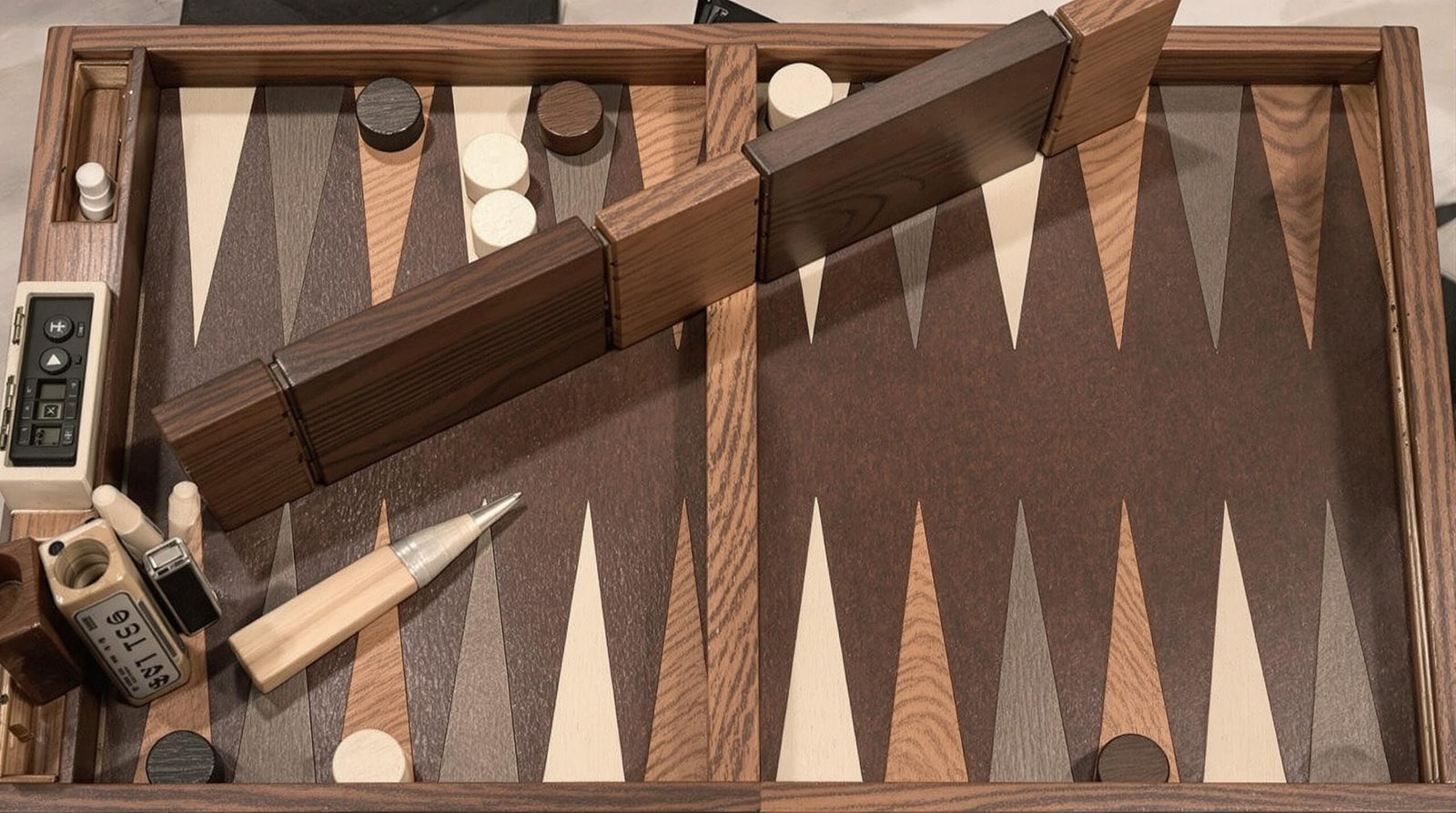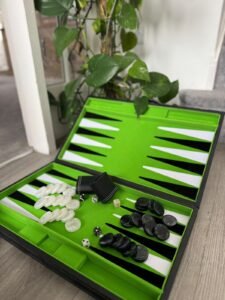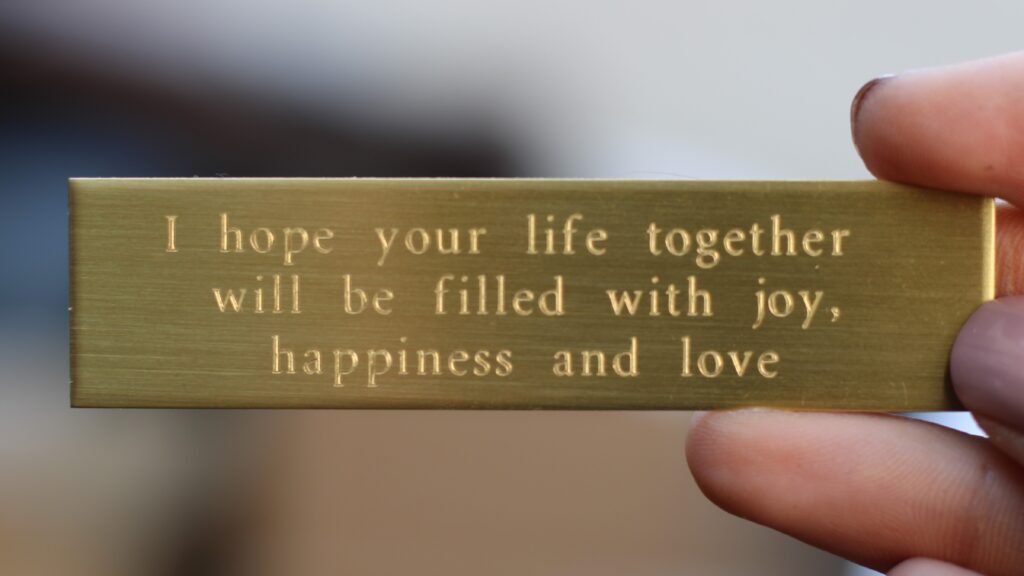
What types of wood are backgammon sets made from?

The timeless game of backgammon has been enjoyed by enthusiasts for thousands of years, with archaeological evidence suggesting its origins can be traced back to ancient Mesopotamia. Beyond the strategic depth and intellectual challenge it offers, a considerable part of backgammon’s appeal lies in the craftsmanship and materials used to create the sets themselves. Among collectors and serious players, the type of wood used in crafting a backgammon board is often as important as the gameplay itself.
Traditional Woods in Backgammon Craftsmanship
Backgammon sets have historically been crafted from a diverse range of timber, with certain woods becoming particularly prized for their aesthetic qualities, durability, and cultural significance. Walnut stands as perhaps the most traditional choice for premium backgammon boards, offering a rich, dark brown colour that develops a lustrous patina over time. The natural grain patterns of walnut create striking visual interest whilst providing the durability needed for a game that may be passed down through generations.
Equally revered is mahogany, which has been used in fine furniture and game manufacturing for centuries. Renowned for its reddish-brown hue and straight grain, mahogany provides an elegant backdrop for the contrasting playing pieces. Traditional British craftsmen have long favoured this imported hardwood for its workability and refined appearance, though concerns about sustainability have somewhat diminished its prevalence in contemporary manufacturing.
For those seeking the pinnacle of luxury, rosewood offers an unmatched combination of visual splendour and aromatic qualities. The deep, often purplish-brown colour with darker veining creates a dramatic playing surface. However, due to its inclusion in CITES (Convention on International Trade in Endangered Species) protection, genuine rosewood is now rarely used in new backgammon sets, making antique rosewood boards particularly valuable collector’s items.
Contemporary Hardwoods in Modern Sets
Today’s backgammon board makers have expanded their material palette to include a broader range of sustainable hardwoods. Oak, with its distinctive grain and honey-coloured tones, has become increasingly popular for boards that blend traditional craftsmanship with a more contemporary aesthetic. English oak carries particular cultural significance in Britain, representing strength and endurance—qualities that align well with the timeless nature of backgammon itself.
Maple offers another excellent alternative, prized for its creamy white to pale reddish-brown appearance. The subtle grain of maple provides an understated elegance, whilst its hardness ensures the board remains flat and true even after decades of use. Often used for the lighter points on the playing surface, maple creates a pleasant contrast when paired with darker woods.
For those seeking something truly distinctive, olive wood from Mediterranean countries offers extraordinary grain patterns with swirling, twisting figures that make each board unique. The warm, golden-brown colour deepens beautifully with age, and the dense structure of olive wood resists warping—a crucial characteristic for maintaining a level playing surface. Many boutique European manufacturers particularly value this wood for its connection to the regions where backgammon has been played for millennia.
Exotic Woods for Premium Collections
At the highest end of the backgammon market, certain exotic woods command extraordinary prices and create truly spectacular boards. Ebony, with its deep black appearance and remarkable density, has been used for centuries in the finest backgammon sets. Often employed for the darker points on the playing surface or as inlay work, genuine ebony is increasingly rare and protected, making it primarily available in vintage sets or as small decorative elements in contemporary boards.
Birdseye maple represents another remarkable option, characterised by distinctive small, circular figures resembling birds’ eyes scattered throughout the grain. This unusual figuring occurs rarely in nature, making birdseye maple highly sought after for decorative purposes. The light colour provides excellent contrast with darker woods, making it ideal for creating the distinctive triangular points on the playing surface.
From the forests of Central and South America comes cocobolo, a spectacularly coloured hardwood ranging from orange to deep reddish-brown with darker striping. Its natural oils give cocobolo a remarkable lustre without requiring additional finishing, whilst also providing natural resistance to wear. However, sustainability concerns and allergic reactions reported by some craftspeople have reduced its availability in recent years.
Veneers and Inlays: Maximising Precious Timbers
Whilst solid wood construction represents the traditional approach to backgammon manufacturing, many contemporary sets utilise veneers—thin slices of premium woods adhered to a stable substrate. This technique allows craftspeople to incorporate rare or costly timbers whilst maintaining structural integrity and reducing overall material consumption.
Burr walnut veneer exemplifies this approach, showcasing the extraordinary figuring found in the burls or growths of walnut trees. The swirling, complex patterns create mesmerising visual effects that would be prohibitively expensive or structurally unsound if used in solid form. Similarly, ziricote veneer, with its dramatic black streaking on a chocolate-brown background, offers an exotic appearance reminiscent of rosewood without the associated conservation concerns.
Master craftspeople often combine multiple wood species through inlay work, creating intricate patterns or decorative borders. Boxwood, with its pale yellow colour and exceptionally fine, even grain, has been traditionally used for delicate inlays against darker backgrounds. The practice of marquetry—creating pictures or patterns from different wood veneers—reaches its pinnacle in some museum-quality backgammon sets, where playing surfaces become genuine works of art.
Sustainable and Alternative Options
As environmental awareness has grown, so too has the market for backgammon sets made from sustainable or alternative materials. Bamboo, technically a grass rather than a wood, offers impressive sustainability credentials due to its rapid growth cycle. Modern manufacturing techniques can create bamboo boards with surprising durability and attractive grain patterns, often at more accessible price points than traditional hardwoods.
Some manufacturers have begun experimenting with reclaimed timber from historical buildings, decommissioned ships, or wine barrels. These materials bring unique character and historical significance to each backgammon set, whilst also reducing demand for newly harvested timber. The weathered appearance and potential history of such woods appeal particularly to players who appreciate the storied tradition of backgammon itself.
Cork represents another innovative material appearing in some contemporary designs. Whilst not strong enough for structural components, cork can provide a pleasant tactile quality for playing surfaces whilst offering excellent sustainability credentials, as its harvest doesn’t require cutting down trees.
Wood Selection and Playing Experience
Beyond aesthetics, the choice of wood significantly influences the playing experience. Denser woods like ebony or cocobolo create a distinctive sound when pieces are moved or when dice are rolled—a sensory element that many serious players consider essential to the full backgammon experience. The acoustic properties of different woods contribute substantially to what enthusiasts describe as the “feel” of a quality set.
The weight of the chosen timber affects the board’s stability during play, with heavier woods generally providing a more solid foundation that won’t shift during enthusiastic gameplay. However, this must be balanced against portability concerns, particularly for tournament players who transport their sets regularly.
Surface texture varies considerably between wood species, with open-grained woods like oak or ash creating a different tactile experience than closed-grain species such as maple or cherry. This subtle difference affects how smoothly pieces glide across the playing surface—a consideration that might seem minor to casual players but can be critically important to serious enthusiasts.
Regional Traditions in Wooden Backgammon Sets
Different regions have developed distinctive traditions in backgammon board construction, often utilising locally available timbers. Middle Eastern sets frequently incorporate olive wood, reflecting both its availability in the region and its cultural significance. The swirling grain patterns of olive wood create boards with remarkable visual interest without requiring additional decoration.
British craftsmanship has traditionally favoured oak, walnut, and imported mahogany, often with restrained decorative elements that emphasise the natural beauty of the wood itself. The cabinet-making tradition in Britain has significantly influenced backgammon design, with many sets reflecting the same attention to joinery and proportion found in fine furniture.
In contrast, Eastern European boards often feature more elaborate inlay work, combining multiple wood species to create geometric patterns or borders. Woods like sycamore, beech, and various fruitwoods feature prominently in this tradition, reflecting both the native timber species and the decorative arts heritage of regions like Bulgaria and Romania.
Caring for Wooden Backgammon Sets
The longevity of a wooden backgammon set depends significantly on proper maintenance. Most quality boards benefit from occasional application of appropriate wood oils or waxes, which nourish the timber and prevent it from drying out and potentially cracking. The specific finish should be selected based on the wood species and existing treatment—beeswax often works well for traditionally finished boards, whilst specialised wood oils may be more appropriate for others.
Environmental factors play a crucial role in wood preservation, with extreme temperature changes and humidity fluctuations representing the primary threats to wooden boards. Players should avoid storing their sets near radiators, in direct sunlight, or in damp conditions. Many collectors keep their premium sets in climate-controlled environments to prevent warping or splitting that can occur when wood expands and contracts with seasonal changes.
The playing surface requires particular attention, as it experiences the most direct contact during games. Felt backing on playing pieces helps minimise scratching, whilst regular cleaning with a soft, dry cloth removes dust that might otherwise become embedded in the grain. Spills should be addressed immediately, as many woods are susceptible to staining or water damage.
Selecting the Right Wooden Backgammon Set
For those considering investing in a wooden backgammon set, several factors beyond the timber itself merit consideration. Construction quality often proves as important as the wood species, with well-executed joinery ensuring the board remains stable and functional for decades. Traditional techniques like dovetail joints or finger joints generally offer superior durability compared to simpler butt joints secured only with adhesive.
The playing surface deserves particular scrutiny, as subtle imperfections can significantly impact gameplay. Points should be precisely cut and consistently sized, with clean delineation between contrasting woods. The surface should be perfectly flat, with no warping that might cause unpredictable dice rolls or piece movement.
Ultimately, personal preference plays a significant role in choosing the right wooden backgammon set. Some players prefer the warm, traditional appearance of walnut or mahogany, whilst others might be drawn to the dramatic figuring of exotic species or the sustainable credentials of newer alternatives. Whatever the choice, a quality wooden backgammon set represents not just a game but an heirloom that can bring pleasure to generations of players.
Conclusion
The diversity of woods used in crafting backgammon sets reflects both the global popularity of this ancient game and the importance players place on the aesthetic and tactile elements of their equipment. From traditional walnut to exotic cocobolo, from solid construction to intricate veneers, the choices available to today’s backgammon enthusiasts are broader than ever before.
As with the game itself, which balances luck and strategy, selecting a wooden backgammon set involves finding the right balance between beauty, functionality, sustainability, and personal preference. Whether purchased as a serious playing instrument, a decorative conversation piece, or an investment in craftsmanship, a wooden backgammon set connects its owner to thousands of years of gaming tradition whilst showcasing the timeless appeal of fine woodworking.





